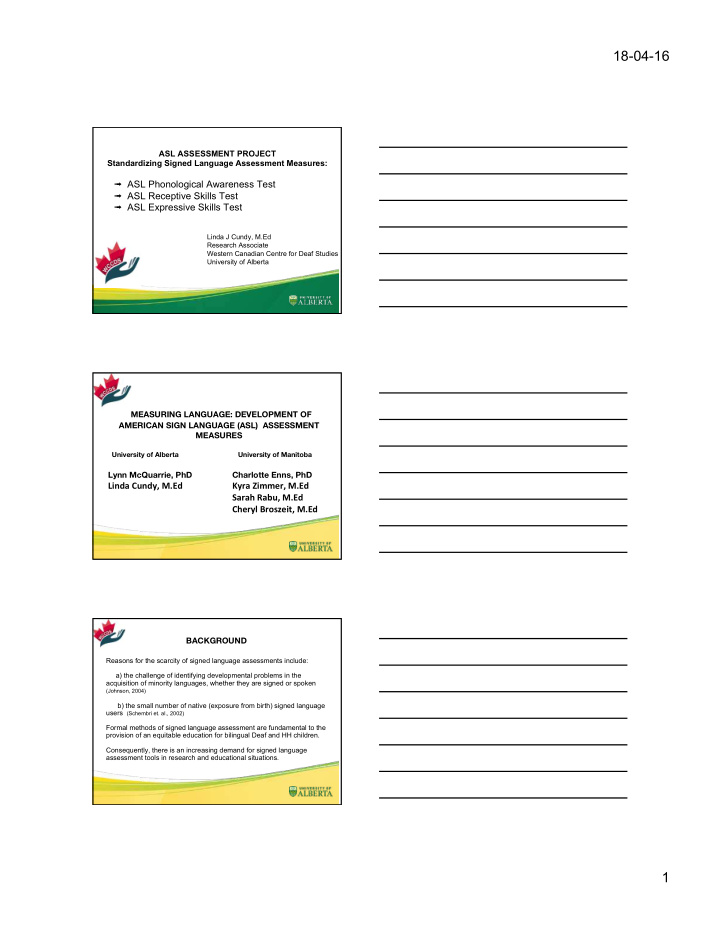



18-04-16 ASL ASSESSMENT PROJECT Standardizing Signed Language Assessment Measures: ➟ ASL Phonological Awareness Test ➟ ASL Receptive Skills Test ➟ ASL Expressive Skills Test Linda J Cundy, M.Ed Research Associate Western Canadian Centre for Deaf Studies University of Alberta MEASURING LANGUAGE: DEVELOPMENT OF AMERICAN SIGN LANGUAGE (ASL) ASSESSMENT MEASURES University of Alberta University of Manitoba Lynn McQuarrie, PhD Charlotte Enns, PhD Linda Cundy, M.Ed Kyra Zimmer, M.Ed Sarah Rabu, M.Ed Cheryl Broszeit, M.Ed BACKGROUND Reasons for the scarcity of signed language assessments include: a) the challenge of identifying developmental problems in the acquisition of minority languages, whether they are signed or spoken (Johnson, 2004) b) the small number of native (exposure from birth) signed language users (Schembri et. al., 2002) Formal methods of signed language assessment are fundamental to the provision of an equitable education for bilingual Deaf and HH children. Consequently, there is an increasing demand for signed language assessment tools in research and educational situations. 1
18-04-16 Methodology FORMAT: one-to-one with an experienced researcher. Each test takes about 15 minutes to complete. The ASL Phonological Awareness Test (ASL-PAT) a) looking at computer-based video of signing b) choosing the correct phonological (HML) match from a choice of pictures. The ASL Receptive Skills Test (ASL-RST) a) viewing computer-based video of signing b) choosing the correct grammatical match from a choice of pictures. The ASL Expressive Skills Test (ASL-EST) a) watching a three-minute movie (with no signing or talking) b) re-telling the story in ASL WHO are the participants? D/HH children between the ages of 4 and 13 years who are willing to participate with parental consent. Data collected from multiple schools with a high number of DHH students in Canada and United States. The ASL Phonological Awareness Test (ASL-PAT) measures a child's awareness of the phonological building blocks of ASL: sub-lexical parameters of handshape [H], location [L], and movement [M]) - web-based assessment application - individual user responses uploaded to a central database in real time - five phases: a) log-in & background demographic data b) vocabulary check c) instruction video in ASL d) practice trials e) test block of 24 items 2
18-04-16 ASL Receptive Test The ASL Receptive Skills Test assesses a child’s comprehension of ASL grammar in phrases and sentences. The test is an adaption of the British Sign Language Receptive Skills Test. (Herman, Holmes, & Woll,1999) The test includes a vocabulary check, practice items and a total of 42 test items. Eight grammatical categories are assessed: negation • number/distribution • noun/verb distinction • spatial verbs (location and movement) • size/shape specifiers • handling classifiers • role shift • conditionals • 3
18-04-16 ASL Receptive Skills Test (ASL-RST) Northern Signs Research, Winnipeg northernsignsresearch.com The test provides you with a standard score of the child's receptive skills in ASL, or whether the child can understand ASL at an appropriate level for his/her age (in comparison to a sample of children normally acquiring ASL). The test also identifies the pattern of correct and incorrect responses regarding specific grammatical structures, thereby indicating strengths and weaknesses in the child's comprehension of ASL. ASL Expressive Skills Test ASL Grammar Narrative Skills Content 4
18-04-16 The ASL Expressive Skills Test (ASL-EST ) assesses story re-telling skill. The process of eliciting narratives (story re- telling) is an e ff ective approach for measuring children’s expressive language development (Cravens, 2013) . This research builds on a test developed for British Sign Language (BSL) to assess children’s narrative skills, and adapts it for use in ASL. Pilot testing is now complete. We hope to release ASL- PAT and ASL-EST in Fall 2018. Developing Accessible Apps Through Co-Design with Deaf Children L. McQuarrie, PhD, E. Lam, BSc, S. Yong, BSc/BDes, L. Cundy, MEd, C. Enns, PhD ASL phonology is a facilitative gateway into early reading in English for bilingual deaf learners (e.g., McQuarrie & Enns, 2015). Through collaborative co-design with deaf children (ages 6-13), we are developing a set of five skill builder dual language (American Sign Language – English) games. 5
18-04-16 Drag and Drop game ASL Phonological Awareness Apps FIND My Handshape Hungry Penguins Butterfly Catcher Endless Waddle Memory Match 6
18-04-16 For further inquiries, contact: Lynn McQuarrie, PhD David Peiko ff Chair of Deaf Studies & Director, WCCDS lynn.mcquarrie@ualberta.ca 7
Recommend
More recommend